Table of Contents
If you are a bonsai enthusiast and looking for some information about the Ficus ginseng bonsai plant, ficus plant for indoor bonsai or ficus ginseng care, you have made the right choice to be here.

This article is a beginner ginseng Ficus bonsai tree care guide where you will find all the information you need about this ginseng ficus bonsai plant. From ficus tree history, general info to care tips and maintenance – we got it all covered for you in this all-in-one article.
Let’s move on and take a deeper dive the art of bonsai ginseng ficus bonsai tree!
| Scientific Name | Ficusmicrocarpa & Ficus retusa |
| Common Name | Ficus ginseng |
| Type of Plant | Indoor, evergreen. |
| Origin of Plant | Southeast Asia, Taiwan & Malaysia |
| Lighting needs | Loves full sunlight, doesn’t like shade |
| Maintenance level | Very easy and beginner-friendly |
| Watering needs | Moderate |
| Toxicity | Toxic for the pets |
Is Ficus ginseng a good option for bonsai?

The first most common question people ask everywhere is that:
Is the Ficus ginseng plant a good option for bonsai or not?
The answer is yes. Ficus ginseng plant is one of the best and perfect choices for bonsai lovers. Experts say that this plant is a great choice for beginners who find it difficult to grow and maintain other kinds of bonsai plants.
The reason is that this bonsai plant needs very little maintenance. It means that you can easily grow it at your home without investing a lot of time, money, and energy. You can also gift this plant to any of your loved ones.
Ficus ginseng bonsai history
Where did this Ficus ginseng bonsai plant come from?
Well, historical references say that the Ficus ginseng bonsai plant is native to the Southeast Asian region. More specifically, this tree belongs to Malaysia and Taiwan. It is widely found in these areas.
Now there are mainly 2 reasons why the Ficus ginseng bonsai plant is so much popular in the entire bonsai community.
The first reason is less maintenance. This plant does not need much of your time and energy. It just requires a little bit of regular maintenance to stay healthy and keep growing.
The second reason is its attractive look. Ficus ginseng bonsai plant has very thick roots that look like the trunk of the tree. The roots of this plant are aerial which means that the roots stay exposed above the surface of the soil. The plant looks like it is standing on its 2 legs.
Ficus ginseng bonsai scientific name
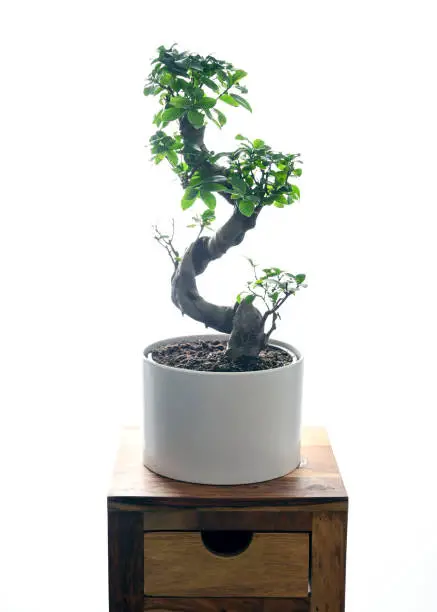
The scientific name of this Ficus ginseng bonsai tree is Ficusmicrocarpa and Ficus retusa.
The scientific name of any plant can be broken down into 2 parts. The first part of the name refers to the genus of the plant whereas the second part of the name refers to the species of the plant.
Plants are known by their scientific names in the scientific community and they are also classified into different taxonomical and botanical groups with the same name.
Ficus ginseng bonsai benefits

You must be wondering why should I get a Ficus ginseng bonsai plant? What are the benefits of this plant?
We got them listed below for you:
1. Purification of air
Plants refresh the air and keep it clean from several different pollutants.
A Ficus ginseng bonsai plant will filter the air in your house and keep it clean.
2. Low maintenance
If you are looking for a plant that does not require much maintenance, then the Ficus ginseng bonsai plant is the right option for you.
This plant requires very little maintenance for staying healthy and growing.
Especially if you are a beginner, this plant is the way to go for you.
3. Attractive look
Everyone loves to see a beautiful plant. Ficus ginseng bonsai plant looks very attractive to the eyes of the viewers.
The roots of this plant are very thick and they stay exposed above the ground level. The plant looks like it is standing on its 2 legs.
The leaves and bark of this plant are also very beautiful. It looks wonderful even when it is small in size.
Therefore, the Ficus ginseng bonsai plant can be a great option for decorating any space you want. You can also gift this cute plant to your friends and loved ones.
4. Unique collection
This plant has a different appearance as compared to the rest of the plants.
Its roots are thick and they stay up in the air (above the surface of the ground). The roots are thicker like the trunk.
The plant’s appearance is like it’s standing on its legs. This is a unique plant that can be an amazing addition to your collection.
Ficus ginseng bonsai care

Taking care of a Ficus ginseng bonsai plant is very easy and simple.
You can successfully grow this plant if you have the right knowledge about its care. You need to know how to water, repot, and fertilize this plant, what soil and the temperature it likes, etc.
Now we are going to teach you every single thing about how to take care of this Ficus ginseng bonsai plant.
Ficus ginseng bonsai temperature

The first most important question is, which temperature is the safest for this bonsai plant?
The experts say that the ginseng ficus plants loves warm weather. It is an indoor plant that is not resistant to frost.
You can keep Ficus Ginseng bonsai outdoors during summer as long as the temperature stays above 60℉ (15℃).
This plant requires a lot of light. So, you should keep it somewhere where it can get full sunlight.
If you are a fan of bonsai that required full sunlight, you might be interest in bonsai calamansi tree, tamarix gallica bonsai, sorbus bonsai, hinoki cypress bonsai and avocado bonsai tree too.
Ficus ginseng bonsai fertilizer

Should you fertilize your Ficus ginseng bonsai plant? If yes, then how often should you fertilize & which fertilizer is the best to use?
The experts recommend that you should fertilize your Ficus Ginseng bonsai after every 2 weeks during summer.
In winter, you can fertilize your plant after every 4 weeks if the growth of your plant has not stopped.
However, you should never fertilize a plant that is not growing or is unhealthy. Doing this will only make the situation worse and hurt your plant.
You can use a liquid fertilizer as well as pellets of organic fertilizer.
Make sure that your fertilizer has a balanced amount of Nitrogen, Phosphorus, and Potassium because your Ficus bonsai plant requires these 3 main elements.
Ficus ginseng bonsai pruning/trimming
Regular pruning/trimming is what makes a bonsai plant different from the other normal plants.
You need to learn when and how should you prune your Ficus ginseng bonsai plant.
Don’t worry because we are going to teach you all of that.
How to prune Ficus ginseng bonsai?
Experts recommend that you should forego pruning for one or two years so your Ficus bonsai tree can grow a thicker trunk and look more attractive.
When your tree is ready for pruning, the thumb rule is that when 6 to 8 leaves have grown, you should prune them back to 2 leaves.
If you are allowing the trunk of your tree to thicken up, then keep in mind that it will grow new shoots from old wood.
Treat all the wounds with cut paste to prevent any disease. Also, make sure to use clean and sharp tools when you are working with your plant.
Ficus ginseng bonsai repotting

Repotting of the Ficus ginseng bonsai plant becomes necessary when its roots have filled up the entire pot.
Experts say that you will have to re-pot your bonsai plant every other year during spring or summer months.
Remove the plant from the pot and cut the outer lower quarter of its roots. Don’t end up cutting too much or it will negatively impact your plant.
Pot the plant again a new pot having basic bonsai soil mixture.
Ficus ginseng bonsai pests and diseases
Can pests and diseases attack your Ficus ginseng bonsai plant? Can they stop the plant’s growth or even kill it completely?
Experts say that the Ficus ginseng bonsai plant is somewhat resistant to pests and disease. However, they can still attack your plant under some special conditions like winter. They can be attacked by spider mites or scales.
You can use an insecticide stick or spray to get rid of all the attacking pests.
Use clean and sharp tools & treat the wounds with cut-paste for the prevention of diseases.
Ficus ginseng bonsai soil
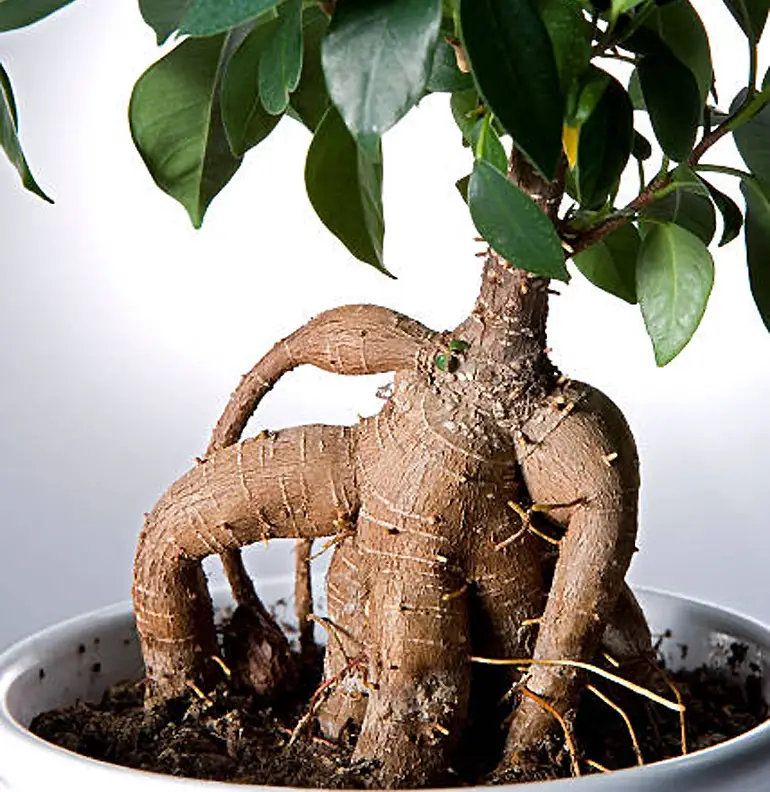
What kind of soil is healthy and safe for your Ficus ginseng bonsai plant?
This is extremely important for you to know if you want to keep your plant healthy and growing.
The best soil for Ficus ginseng bonsai
The experts say that this plant does very well in a soil mixture that has forty percent organic matter and sixty percent aggregate.
You can either go to the market and purchase a premix OR you can even make your own by using lava rock, akadama, pine bark, etc.
Ficus ginseng bonsai watering

The way your water your plant has a direct impact on its health and growth.
We will teach you how often you should water your plant and how should you water your Ficus ginseng bonsai plant.
How often to water Ficus ginseng bonsai?
You are recommended to only water your plant when its soil seems slightly dry to you.
How to water ginseng Ficus bonsai?
You should also perform misting of the plant on daily basis for maintaining the humidity.
However, you should never water your plant to such an extent that it starts dripping with water. It will make your plant vulnerable to fungal attacks.
If you have kept the plant in a warm environment then it will need more frequent watering.
Ficus ginseng bonsai sunlight requirements
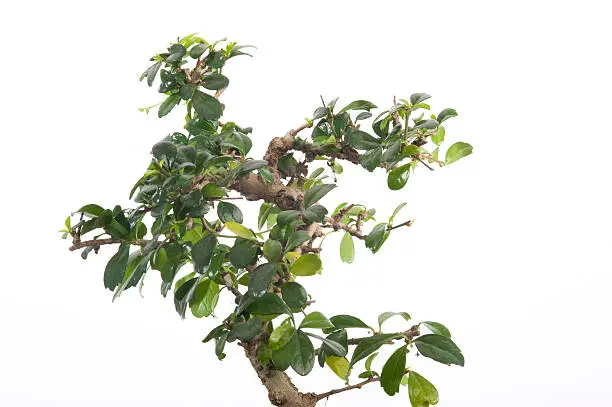
Your Ficus ginseng bonsai plant requires plenty of light all the time. So, you should not place it in shady and dark locations.
You can keep your plant outdoors under direct sunlight as long as the temperature is above 60 degrees Fahrenheit or 15 degrees Celsius.
We recommend you keep your plat at the windowsill where it can get enough bright light. If that’s not possible then we recommend using plant lights.
Whatever option you choose, just keep in mind that this plant does not tolerate shade. So, please provide enough light to keep the plant alive and healthy.
Types of Ficus ginseng bonsai
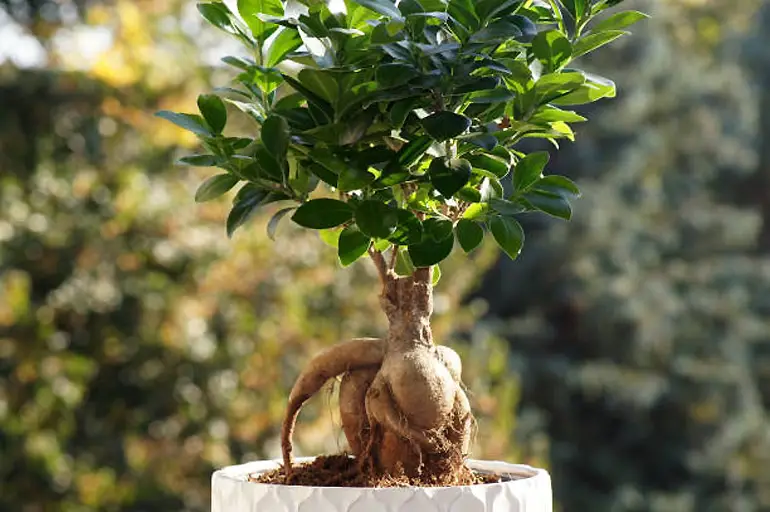
How many different types of Ficus bonsai plants are out there?
Well, experts say that there is different information available as of now about the exact number of species of Ficus bonsai plant that have been discovered.
A rough idea is that there are about 800 to 2000 different species of the Ficus bonsai plant.
Ficus ginseng is itself a very popular type of the Ficus bonsai plant.
Is Ficusmicrocarpa ginseng a bonsai tree?
The answer is yes. Ficusmicrocarpa ginseng is a bonsai tree.
This bonsai plant is a perfect choice for beginners. You can easily grow this bonsai plant without doing any complex maintenances.
The plant grows oval-shaped small green leaves that look very beautiful. The roots of these plants are thick and aerial (aerial root) which means that they are exposed above the surface of the soil.
The roots give a uniquely attractive appearance to this plant and that’s why it is so popular in the bonsai community.
Is Ficus ginseng bonsai safe for cats?
No, a Ficus ginseng bonsai plant is not safe for cats.
Safety is a big concern for all of us.
If you have a pet cat at home, you must be wondering whether this plant is safe for your cat or not.
Experts say that the Ficus ginseng bonsai plant is poisonous for pets including your cat. If the cat will eat the leaves of this plant, then it can be very dangerous for its health. This plant is not intended for consumption by either humans or animals.
So, now that you have a cat at home, does this mean you should not keep this plant?
No, you can still keep this plant but you just have to be careful. Just make sure that the Ficus ginseng bonsai plant is out of the reach of your cat.
Just keep your pet away from this plant and everything will be okay.
Is Ficus ginseng bonsai safe for humans?
You should not consume Ficus Ginseng bonsai.
If you have latex allergies, then you are recommended to wear gloves when handling this plant.
Ficus ginseng bonsai lifespan

How long can the Ficus ginseng bonsai plants live?
The answer is more than 1000 years.
Surprised, right?
Ficus trees are one of the oldest trees found on earth. They can live for a very long time.
Common Ficus bonsai problems
What are some common problems that Ficus bonsai plant owners face & how can you fix them?
Let’s take a detailed look at all of them:
1. Loss of leaves
It mostly occurs due to a change of temperature or lack of light.
You need to provide plenty of light to this plant all the time and also keep it under a suitable temperature which is above 60F or 15C.
2. Anthracnose
This is a common problem in which some rust spots appear on the leaves and stem of the plant.
This is fixed by removing the diseased parts of the plant and then providing it with appropriate care such as enough light, suitable temperature, enough watering, fertilization, etc.
3. Attack of fungus on leaves
The fungus attacks the leaves of your plant under unfavorable conditions. The leaves turn yellow and then they eventually die.
You can treat it by using fungicides.
4. Oozing sap
This condition is caused by pests like mealybugs. It can kill your plant if not treated on time.
You can use a specific pesticide, fungicide, or solution of one tablespoon of soap added in one pint of water.
How to make ginseng Ficus bonsai?

Generally, there are 2 main ways of growing a ginseng Ficus bonsai:
- By seeds – In this method, you have to take healthy seeds and sow them in suitable soil. The seeds germinate and then grow into a plant if you take care of them well.
- By cutting – In this method, you take a cutting of another Ficus ginseng bonsai plant and sow them in soil. It develops roots and then grows into a full Ficus ginseng bonsai plant that is identical to the plant whose cuttings were used. You will have to take good care of the whole process to make it successful.
Why is Ficus ginseng bonsai losing leaves?
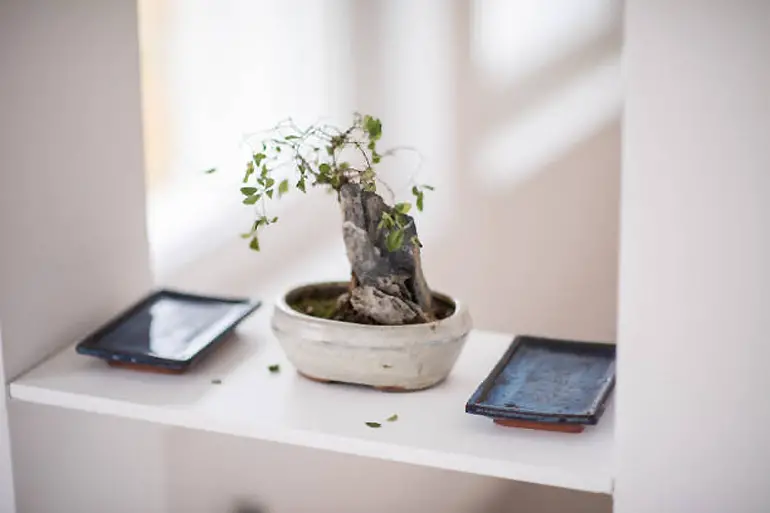
Is your Ficus ginseng bonsai losing its leaves? Here are all the possible reasons behind that:
1. Lack of light
Ficus ginseng bonsai plant requires a lot of light. If you have placed the plant somewhere in the shade or dark then it will fail to produce food for its leaves. So, the plant will start drying and lose its leaves.
2. Poor watering
If you are being careless and never watered the plant despite the hot temperature outside, then the plant will dry out and lose its leaves.
Similarly, if you are frequently giving too much water to this plant then its roots will start rotting and the plant will lose its leaves.
3. Poor fertilization
If you have never fertilized your plant and there is a lack of nutrients in the soil, then your plant won’t get enough food and it’ll lose its leaves.
Similarly, giving too much fertilizer or using the wrong fertilizer will also cause the plant to lose leaves.
4. Attack of pests and disease
If your plant is attacked by insects and diseases and you have done nothing for treatment then they will slowly kill your plant and cause loss of leaves.
How to save a dying ginseng Ficus bonsai?

If your Ficus ginseng bonsai is dying, the only way to revive is by providing proper CARE to the plant.
Here is a quick action plan to start with:
1. Repot the plant
You need to re-pot the plant as the first rescue step. Cut the lower outer quarter of the roots and plant your tree back in a healthy basic bonsai soil mixture.
2. More light
Put your plant somewhere where it can get plenty of light. This bonsai plant hates shade and darkness.
3. Fertilize
Always feed the right amount of fertilizer to your plant at the right time. It will boost the growth of your plant.
4. Watering on time
You need to only water this plant when the soil seems dry. Do not overwater the plant and it will stay healthy. These were some of the quick steps you can take for saving a Ficus ginseng bonsai that is dying or have dead branches.
![Pittosporum Bonsai [Pittosporum Tobira]](https://www.bonsai-express.com/wp-content/uploads/2022/05/Pittosporum-Bonsai-365x200.jpg)
![Sorbus Bonsai [Sorbus Aucuparia]](https://www.bonsai-express.com/wp-content/uploads/2022/05/Sorbus-Bonsai-365x200.jpg)
![Tsuga Bonsai [Tsuga Canadensis]](https://www.bonsai-express.com/wp-content/uploads/2022/05/Tsuga-Bonsai-365x200.jpg)
![Tamarix Bonsai [Tamarix Ramosissima]](https://www.bonsai-express.com/wp-content/uploads/2022/05/Tamarix-Bonsai-365x200.jpg)